The Building and Construction Industry Security of Payments Act Report
VerifiedAdded on 2022/11/13
|7
|1516
|266
Report
AI Summary
This report provides a comprehensive analysis of the Building and Construction Industry Security of Payments Act of 1999 in New South Wales, examining its purpose, workings, and amendments. It delves into the Act's role in ensuring payment security for construction work, addressing issues of delayed payments and the rights of subcontractors. The report outlines the adjudication process, recent amendments, and the impact of the Act on the construction industry, including the rights of unpaid subcontractors and the importance of proper cash flow. It also discusses the Act's success in enhancing communication and dispute resolution within the industry. The report highlights the Act's significance in protecting subcontractors from financial strain and ensuring fair payment practices.

2607 1
2607
Name
Institution
Date
1
2607
Name
Institution
Date
1
Paraphrase This Document
Need a fresh take? Get an instant paraphrase of this document with our AI Paraphraser
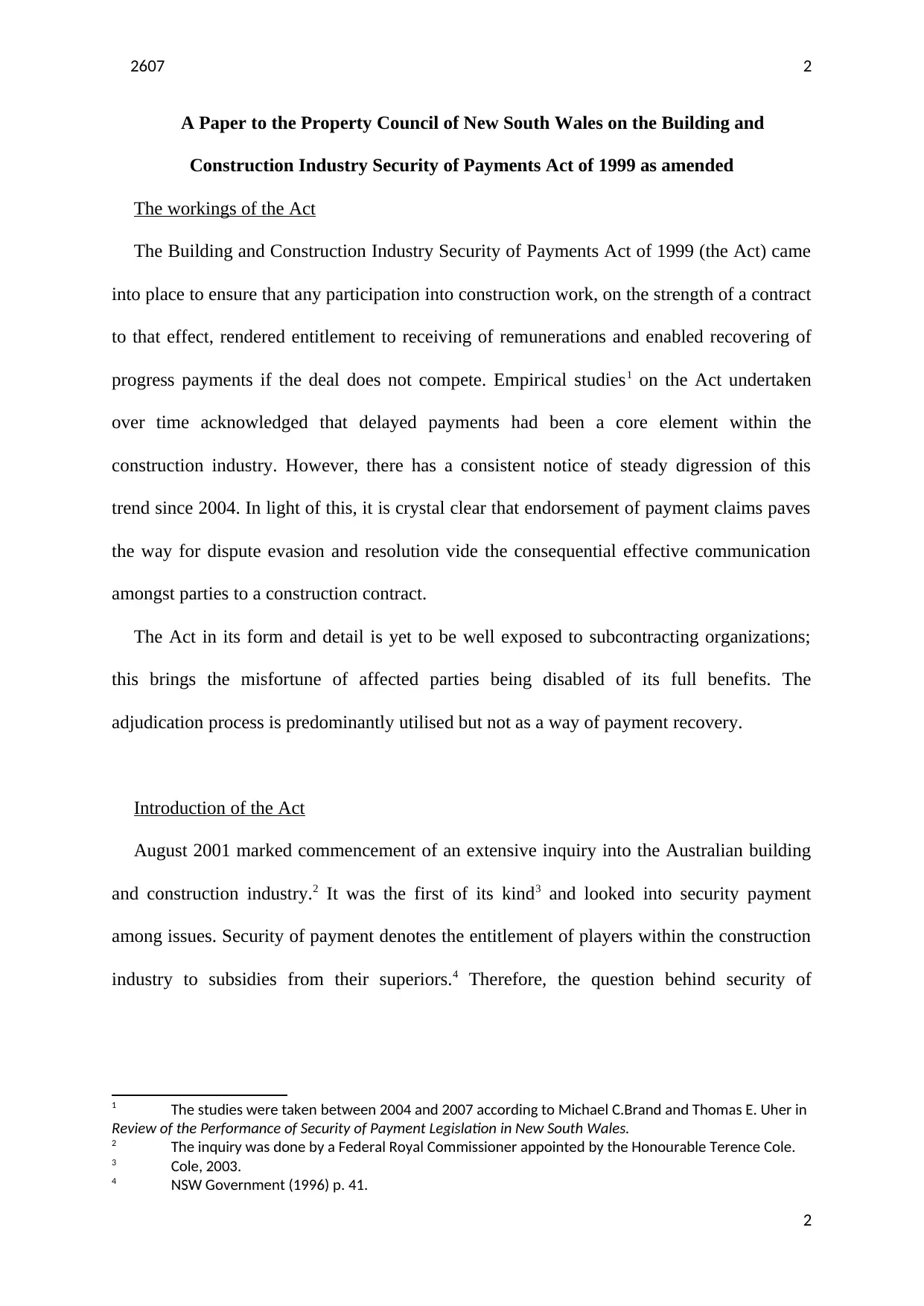
2607 2
A Paper to the Property Council of New South Wales on the Building and
Construction Industry Security of Payments Act of 1999 as amended
The workings of the Act
The Building and Construction Industry Security of Payments Act of 1999 (the Act) came
into place to ensure that any participation into construction work, on the strength of a contract
to that effect, rendered entitlement to receiving of remunerations and enabled recovering of
progress payments if the deal does not compete. Empirical studies1 on the Act undertaken
over time acknowledged that delayed payments had been a core element within the
construction industry. However, there has a consistent notice of steady digression of this
trend since 2004. In light of this, it is crystal clear that endorsement of payment claims paves
the way for dispute evasion and resolution vide the consequential effective communication
amongst parties to a construction contract.
The Act in its form and detail is yet to be well exposed to subcontracting organizations;
this brings the misfortune of affected parties being disabled of its full benefits. The
adjudication process is predominantly utilised but not as a way of payment recovery.
Introduction of the Act
August 2001 marked commencement of an extensive inquiry into the Australian building
and construction industry.2 It was the first of its kind3 and looked into security payment
among issues. Security of payment denotes the entitlement of players within the construction
industry to subsidies from their superiors.4 Therefore, the question behind security of
1 The studies were taken between 2004 and 2007 according to Michael C.Brand and Thomas E. Uher in
Review of the Performance of Security of Payment Legislation in New South Wales.
2 The inquiry was done by a Federal Royal Commissioner appointed by the Honourable Terence Cole.
3 Cole, 2003.
4 NSW Government (1996) p. 41.
2
A Paper to the Property Council of New South Wales on the Building and
Construction Industry Security of Payments Act of 1999 as amended
The workings of the Act
The Building and Construction Industry Security of Payments Act of 1999 (the Act) came
into place to ensure that any participation into construction work, on the strength of a contract
to that effect, rendered entitlement to receiving of remunerations and enabled recovering of
progress payments if the deal does not compete. Empirical studies1 on the Act undertaken
over time acknowledged that delayed payments had been a core element within the
construction industry. However, there has a consistent notice of steady digression of this
trend since 2004. In light of this, it is crystal clear that endorsement of payment claims paves
the way for dispute evasion and resolution vide the consequential effective communication
amongst parties to a construction contract.
The Act in its form and detail is yet to be well exposed to subcontracting organizations;
this brings the misfortune of affected parties being disabled of its full benefits. The
adjudication process is predominantly utilised but not as a way of payment recovery.
Introduction of the Act
August 2001 marked commencement of an extensive inquiry into the Australian building
and construction industry.2 It was the first of its kind3 and looked into security payment
among issues. Security of payment denotes the entitlement of players within the construction
industry to subsidies from their superiors.4 Therefore, the question behind security of
1 The studies were taken between 2004 and 2007 according to Michael C.Brand and Thomas E. Uher in
Review of the Performance of Security of Payment Legislation in New South Wales.
2 The inquiry was done by a Federal Royal Commissioner appointed by the Honourable Terence Cole.
3 Cole, 2003.
4 NSW Government (1996) p. 41.
2
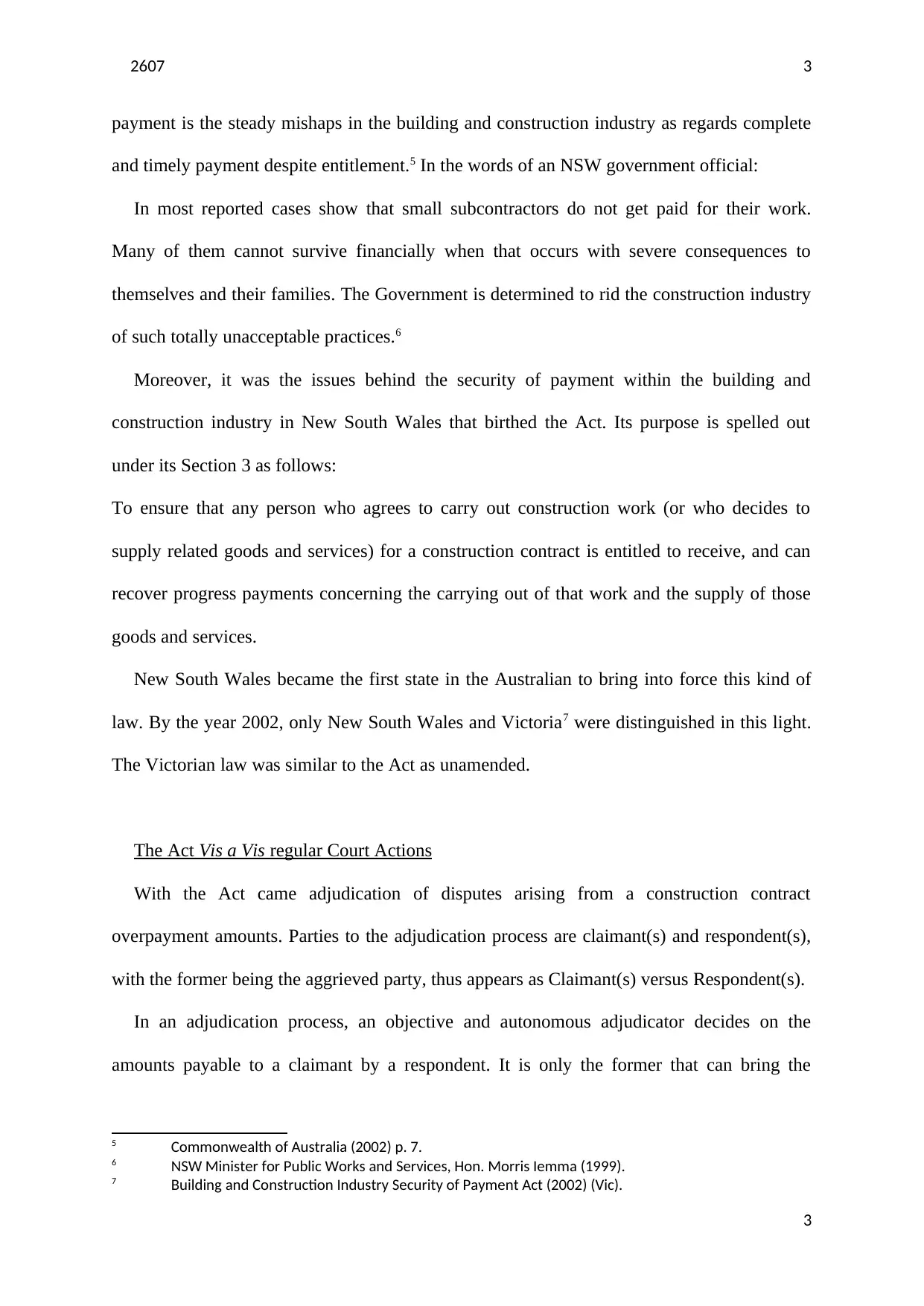
2607 3
payment is the steady mishaps in the building and construction industry as regards complete
and timely payment despite entitlement.5 In the words of an NSW government official:
In most reported cases show that small subcontractors do not get paid for their work.
Many of them cannot survive financially when that occurs with severe consequences to
themselves and their families. The Government is determined to rid the construction industry
of such totally unacceptable practices.6
Moreover, it was the issues behind the security of payment within the building and
construction industry in New South Wales that birthed the Act. Its purpose is spelled out
under its Section 3 as follows:
To ensure that any person who agrees to carry out construction work (or who decides to
supply related goods and services) for a construction contract is entitled to receive, and can
recover progress payments concerning the carrying out of that work and the supply of those
goods and services.
New South Wales became the first state in the Australian to bring into force this kind of
law. By the year 2002, only New South Wales and Victoria7 were distinguished in this light.
The Victorian law was similar to the Act as unamended.
The Act Vis a Vis regular Court Actions
With the Act came adjudication of disputes arising from a construction contract
overpayment amounts. Parties to the adjudication process are claimant(s) and respondent(s),
with the former being the aggrieved party, thus appears as Claimant(s) versus Respondent(s).
In an adjudication process, an objective and autonomous adjudicator decides on the
amounts payable to a claimant by a respondent. It is only the former that can bring the
5 Commonwealth of Australia (2002) p. 7.
6 NSW Minister for Public Works and Services, Hon. Morris Iemma (1999).
7 Building and Construction Industry Security of Payment Act (2002) (Vic).
3
payment is the steady mishaps in the building and construction industry as regards complete
and timely payment despite entitlement.5 In the words of an NSW government official:
In most reported cases show that small subcontractors do not get paid for their work.
Many of them cannot survive financially when that occurs with severe consequences to
themselves and their families. The Government is determined to rid the construction industry
of such totally unacceptable practices.6
Moreover, it was the issues behind the security of payment within the building and
construction industry in New South Wales that birthed the Act. Its purpose is spelled out
under its Section 3 as follows:
To ensure that any person who agrees to carry out construction work (or who decides to
supply related goods and services) for a construction contract is entitled to receive, and can
recover progress payments concerning the carrying out of that work and the supply of those
goods and services.
New South Wales became the first state in the Australian to bring into force this kind of
law. By the year 2002, only New South Wales and Victoria7 were distinguished in this light.
The Victorian law was similar to the Act as unamended.
The Act Vis a Vis regular Court Actions
With the Act came adjudication of disputes arising from a construction contract
overpayment amounts. Parties to the adjudication process are claimant(s) and respondent(s),
with the former being the aggrieved party, thus appears as Claimant(s) versus Respondent(s).
In an adjudication process, an objective and autonomous adjudicator decides on the
amounts payable to a claimant by a respondent. It is only the former that can bring the
5 Commonwealth of Australia (2002) p. 7.
6 NSW Minister for Public Works and Services, Hon. Morris Iemma (1999).
7 Building and Construction Industry Security of Payment Act (2002) (Vic).
3
⊘ This is a preview!⊘
Do you want full access?
Subscribe today to unlock all pages.

Trusted by 1+ million students worldwide
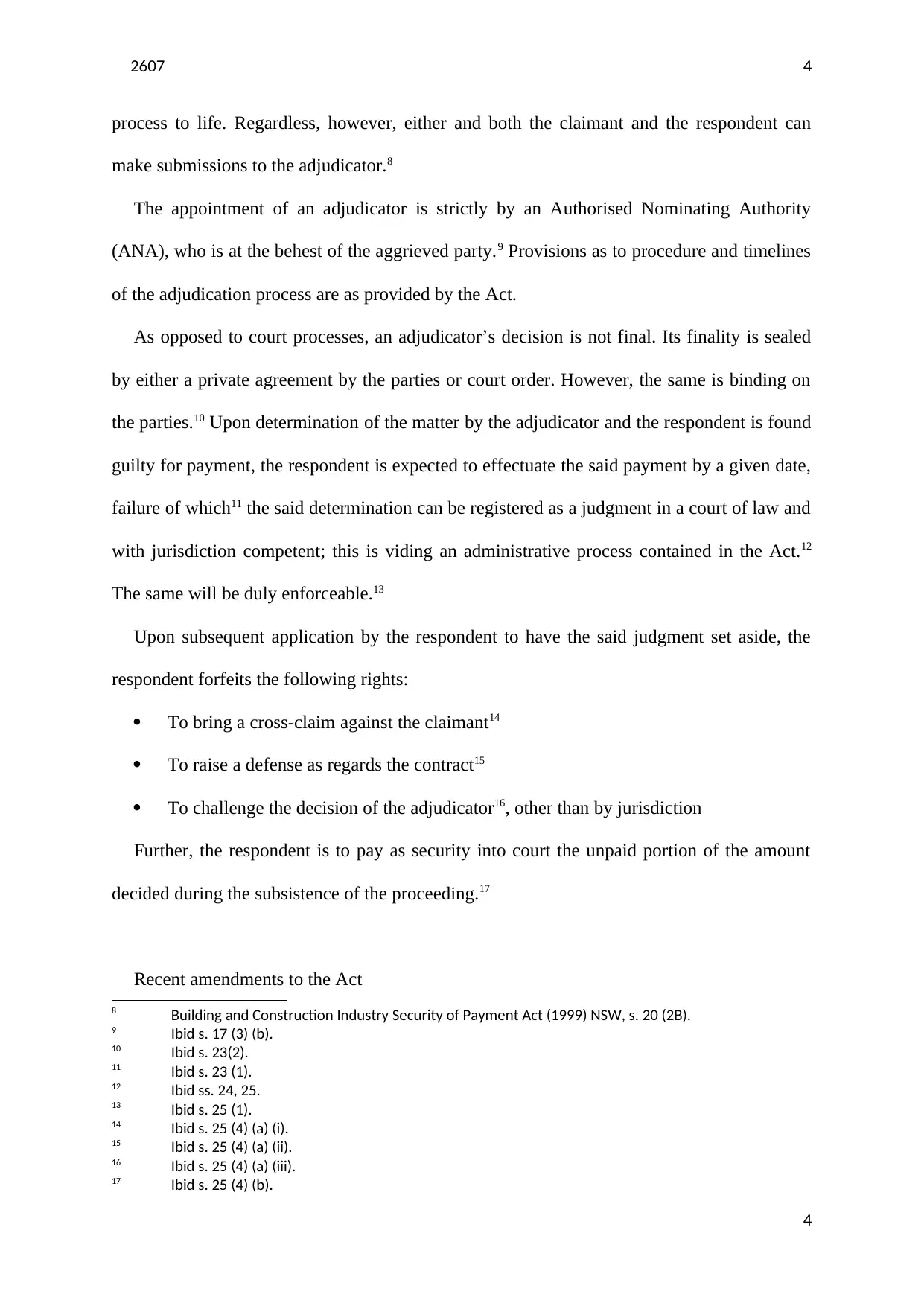
2607 4
process to life. Regardless, however, either and both the claimant and the respondent can
make submissions to the adjudicator.8
The appointment of an adjudicator is strictly by an Authorised Nominating Authority
(ANA), who is at the behest of the aggrieved party.9 Provisions as to procedure and timelines
of the adjudication process are as provided by the Act.
As opposed to court processes, an adjudicator’s decision is not final. Its finality is sealed
by either a private agreement by the parties or court order. However, the same is binding on
the parties.10 Upon determination of the matter by the adjudicator and the respondent is found
guilty for payment, the respondent is expected to effectuate the said payment by a given date,
failure of which11 the said determination can be registered as a judgment in a court of law and
with jurisdiction competent; this is viding an administrative process contained in the Act.12
The same will be duly enforceable.13
Upon subsequent application by the respondent to have the said judgment set aside, the
respondent forfeits the following rights:
To bring a cross-claim against the claimant14
To raise a defense as regards the contract15
To challenge the decision of the adjudicator16, other than by jurisdiction
Further, the respondent is to pay as security into court the unpaid portion of the amount
decided during the subsistence of the proceeding.17
Recent amendments to the Act
8 Building and Construction Industry Security of Payment Act (1999) NSW, s. 20 (2B).
9 Ibid s. 17 (3) (b).
10 Ibid s. 23(2).
11 Ibid s. 23 (1).
12 Ibid ss. 24, 25.
13 Ibid s. 25 (1).
14 Ibid s. 25 (4) (a) (i).
15 Ibid s. 25 (4) (a) (ii).
16 Ibid s. 25 (4) (a) (iii).
17 Ibid s. 25 (4) (b).
4
process to life. Regardless, however, either and both the claimant and the respondent can
make submissions to the adjudicator.8
The appointment of an adjudicator is strictly by an Authorised Nominating Authority
(ANA), who is at the behest of the aggrieved party.9 Provisions as to procedure and timelines
of the adjudication process are as provided by the Act.
As opposed to court processes, an adjudicator’s decision is not final. Its finality is sealed
by either a private agreement by the parties or court order. However, the same is binding on
the parties.10 Upon determination of the matter by the adjudicator and the respondent is found
guilty for payment, the respondent is expected to effectuate the said payment by a given date,
failure of which11 the said determination can be registered as a judgment in a court of law and
with jurisdiction competent; this is viding an administrative process contained in the Act.12
The same will be duly enforceable.13
Upon subsequent application by the respondent to have the said judgment set aside, the
respondent forfeits the following rights:
To bring a cross-claim against the claimant14
To raise a defense as regards the contract15
To challenge the decision of the adjudicator16, other than by jurisdiction
Further, the respondent is to pay as security into court the unpaid portion of the amount
decided during the subsistence of the proceeding.17
Recent amendments to the Act
8 Building and Construction Industry Security of Payment Act (1999) NSW, s. 20 (2B).
9 Ibid s. 17 (3) (b).
10 Ibid s. 23(2).
11 Ibid s. 23 (1).
12 Ibid ss. 24, 25.
13 Ibid s. 25 (1).
14 Ibid s. 25 (4) (a) (i).
15 Ibid s. 25 (4) (a) (ii).
16 Ibid s. 25 (4) (a) (iii).
17 Ibid s. 25 (4) (b).
4
Paraphrase This Document
Need a fresh take? Get an instant paraphrase of this document with our AI Paraphraser
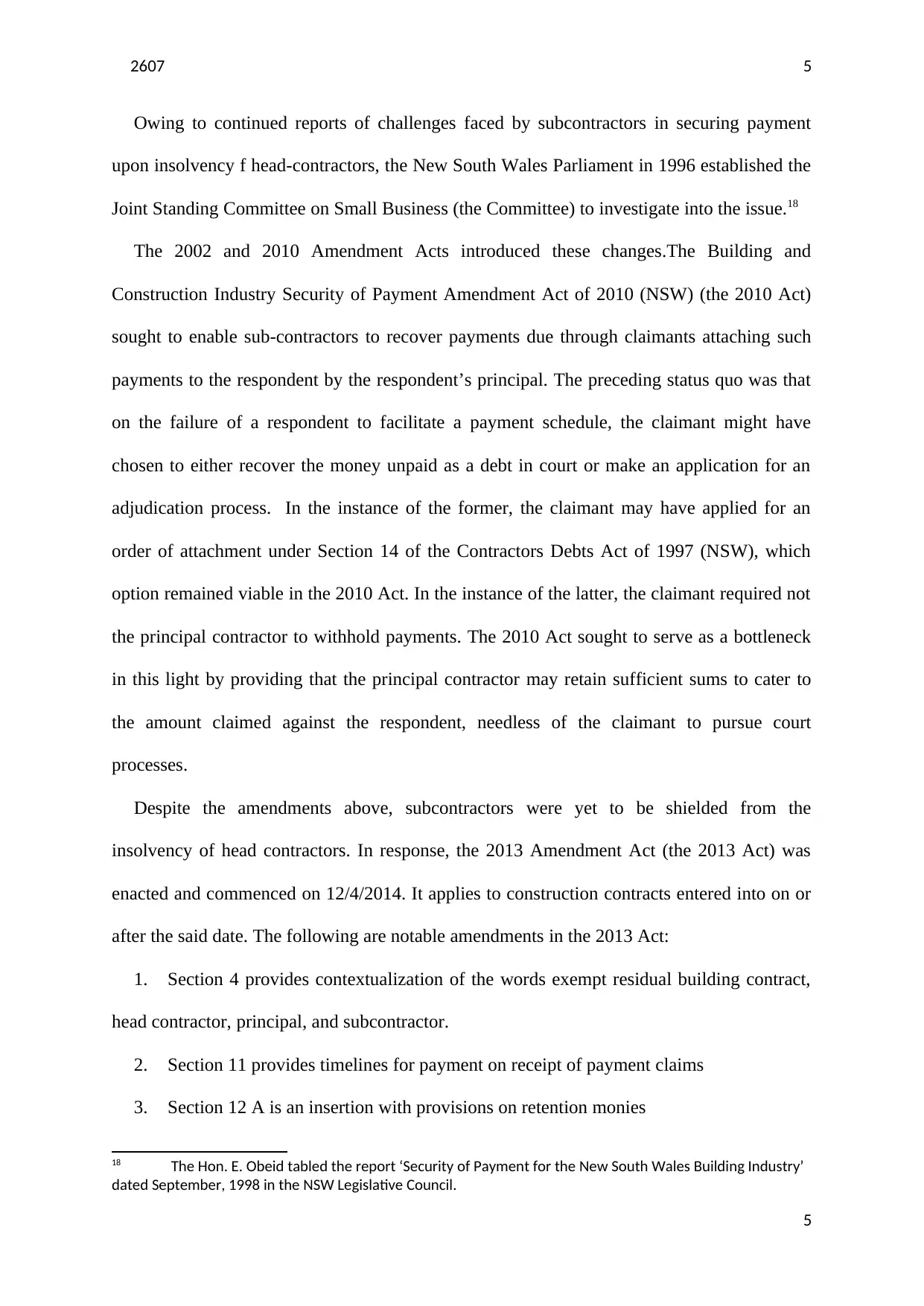
2607 5
Owing to continued reports of challenges faced by subcontractors in securing payment
upon insolvency f head-contractors, the New South Wales Parliament in 1996 established the
Joint Standing Committee on Small Business (the Committee) to investigate into the issue.18
The 2002 and 2010 Amendment Acts introduced these changes.The Building and
Construction Industry Security of Payment Amendment Act of 2010 (NSW) (the 2010 Act)
sought to enable sub-contractors to recover payments due through claimants attaching such
payments to the respondent by the respondent’s principal. The preceding status quo was that
on the failure of a respondent to facilitate a payment schedule, the claimant might have
chosen to either recover the money unpaid as a debt in court or make an application for an
adjudication process. In the instance of the former, the claimant may have applied for an
order of attachment under Section 14 of the Contractors Debts Act of 1997 (NSW), which
option remained viable in the 2010 Act. In the instance of the latter, the claimant required not
the principal contractor to withhold payments. The 2010 Act sought to serve as a bottleneck
in this light by providing that the principal contractor may retain sufficient sums to cater to
the amount claimed against the respondent, needless of the claimant to pursue court
processes.
Despite the amendments above, subcontractors were yet to be shielded from the
insolvency of head contractors. In response, the 2013 Amendment Act (the 2013 Act) was
enacted and commenced on 12/4/2014. It applies to construction contracts entered into on or
after the said date. The following are notable amendments in the 2013 Act:
1. Section 4 provides contextualization of the words exempt residual building contract,
head contractor, principal, and subcontractor.
2. Section 11 provides timelines for payment on receipt of payment claims
3. Section 12 A is an insertion with provisions on retention monies
18 The Hon. E. Obeid tabled the report ‘Security of Payment for the New South Wales Building Industry’
dated September, 1998 in the NSW Legislative Council.
5
Owing to continued reports of challenges faced by subcontractors in securing payment
upon insolvency f head-contractors, the New South Wales Parliament in 1996 established the
Joint Standing Committee on Small Business (the Committee) to investigate into the issue.18
The 2002 and 2010 Amendment Acts introduced these changes.The Building and
Construction Industry Security of Payment Amendment Act of 2010 (NSW) (the 2010 Act)
sought to enable sub-contractors to recover payments due through claimants attaching such
payments to the respondent by the respondent’s principal. The preceding status quo was that
on the failure of a respondent to facilitate a payment schedule, the claimant might have
chosen to either recover the money unpaid as a debt in court or make an application for an
adjudication process. In the instance of the former, the claimant may have applied for an
order of attachment under Section 14 of the Contractors Debts Act of 1997 (NSW), which
option remained viable in the 2010 Act. In the instance of the latter, the claimant required not
the principal contractor to withhold payments. The 2010 Act sought to serve as a bottleneck
in this light by providing that the principal contractor may retain sufficient sums to cater to
the amount claimed against the respondent, needless of the claimant to pursue court
processes.
Despite the amendments above, subcontractors were yet to be shielded from the
insolvency of head contractors. In response, the 2013 Amendment Act (the 2013 Act) was
enacted and commenced on 12/4/2014. It applies to construction contracts entered into on or
after the said date. The following are notable amendments in the 2013 Act:
1. Section 4 provides contextualization of the words exempt residual building contract,
head contractor, principal, and subcontractor.
2. Section 11 provides timelines for payment on receipt of payment claims
3. Section 12 A is an insertion with provisions on retention monies
18 The Hon. E. Obeid tabled the report ‘Security of Payment for the New South Wales Building Industry’
dated September, 1998 in the NSW Legislative Council.
5
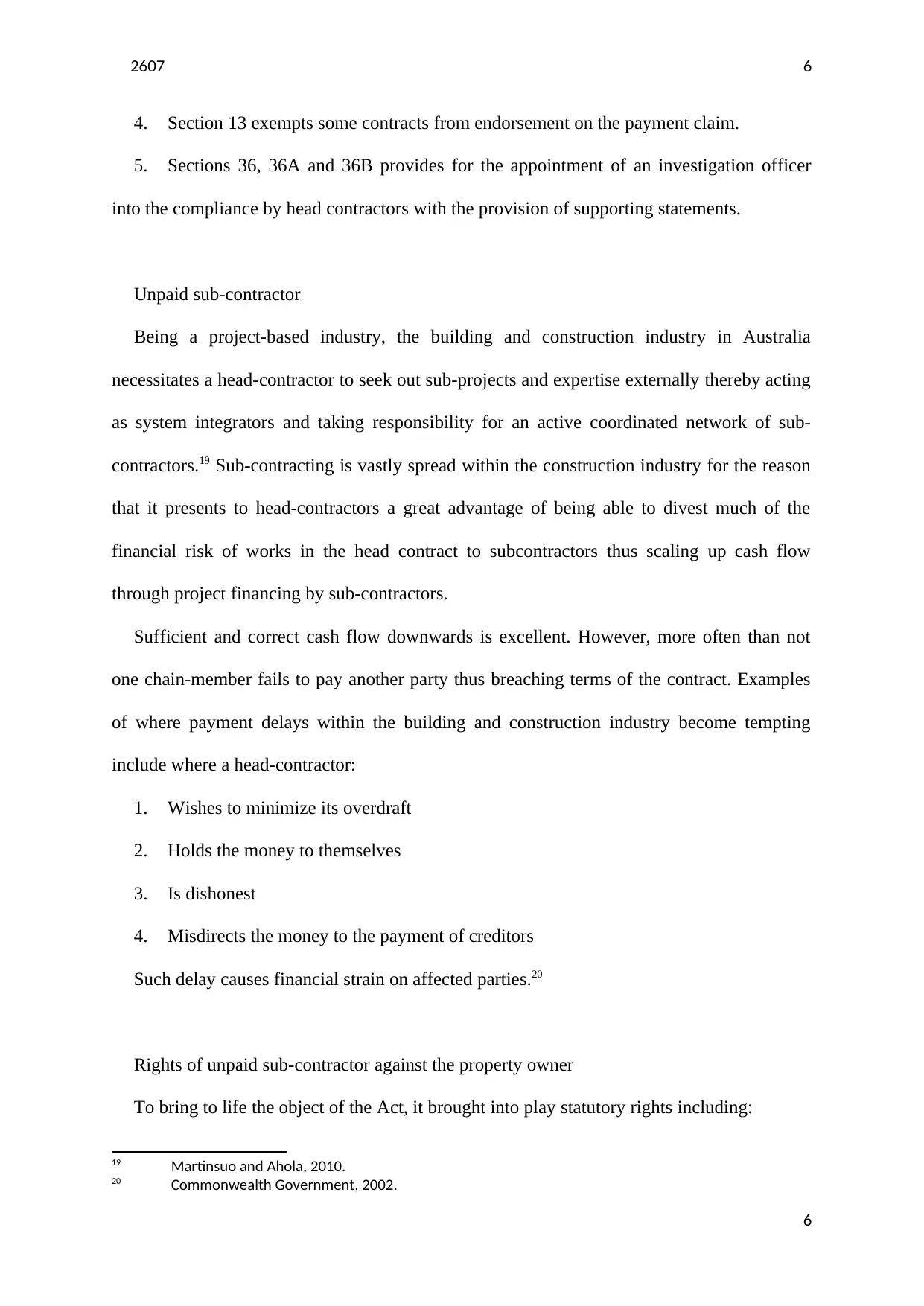
2607 6
4. Section 13 exempts some contracts from endorsement on the payment claim.
5. Sections 36, 36A and 36B provides for the appointment of an investigation officer
into the compliance by head contractors with the provision of supporting statements.
Unpaid sub-contractor
Being a project-based industry, the building and construction industry in Australia
necessitates a head-contractor to seek out sub-projects and expertise externally thereby acting
as system integrators and taking responsibility for an active coordinated network of sub-
contractors.19 Sub-contracting is vastly spread within the construction industry for the reason
that it presents to head-contractors a great advantage of being able to divest much of the
financial risk of works in the head contract to subcontractors thus scaling up cash flow
through project financing by sub-contractors.
Sufficient and correct cash flow downwards is excellent. However, more often than not
one chain-member fails to pay another party thus breaching terms of the contract. Examples
of where payment delays within the building and construction industry become tempting
include where a head-contractor:
1. Wishes to minimize its overdraft
2. Holds the money to themselves
3. Is dishonest
4. Misdirects the money to the payment of creditors
Such delay causes financial strain on affected parties.20
Rights of unpaid sub-contractor against the property owner
To bring to life the object of the Act, it brought into play statutory rights including:
19 Martinsuo and Ahola, 2010.
20 Commonwealth Government, 2002.
6
4. Section 13 exempts some contracts from endorsement on the payment claim.
5. Sections 36, 36A and 36B provides for the appointment of an investigation officer
into the compliance by head contractors with the provision of supporting statements.
Unpaid sub-contractor
Being a project-based industry, the building and construction industry in Australia
necessitates a head-contractor to seek out sub-projects and expertise externally thereby acting
as system integrators and taking responsibility for an active coordinated network of sub-
contractors.19 Sub-contracting is vastly spread within the construction industry for the reason
that it presents to head-contractors a great advantage of being able to divest much of the
financial risk of works in the head contract to subcontractors thus scaling up cash flow
through project financing by sub-contractors.
Sufficient and correct cash flow downwards is excellent. However, more often than not
one chain-member fails to pay another party thus breaching terms of the contract. Examples
of where payment delays within the building and construction industry become tempting
include where a head-contractor:
1. Wishes to minimize its overdraft
2. Holds the money to themselves
3. Is dishonest
4. Misdirects the money to the payment of creditors
Such delay causes financial strain on affected parties.20
Rights of unpaid sub-contractor against the property owner
To bring to life the object of the Act, it brought into play statutory rights including:
19 Martinsuo and Ahola, 2010.
20 Commonwealth Government, 2002.
6
⊘ This is a preview!⊘
Do you want full access?
Subscribe today to unlock all pages.

Trusted by 1+ million students worldwide
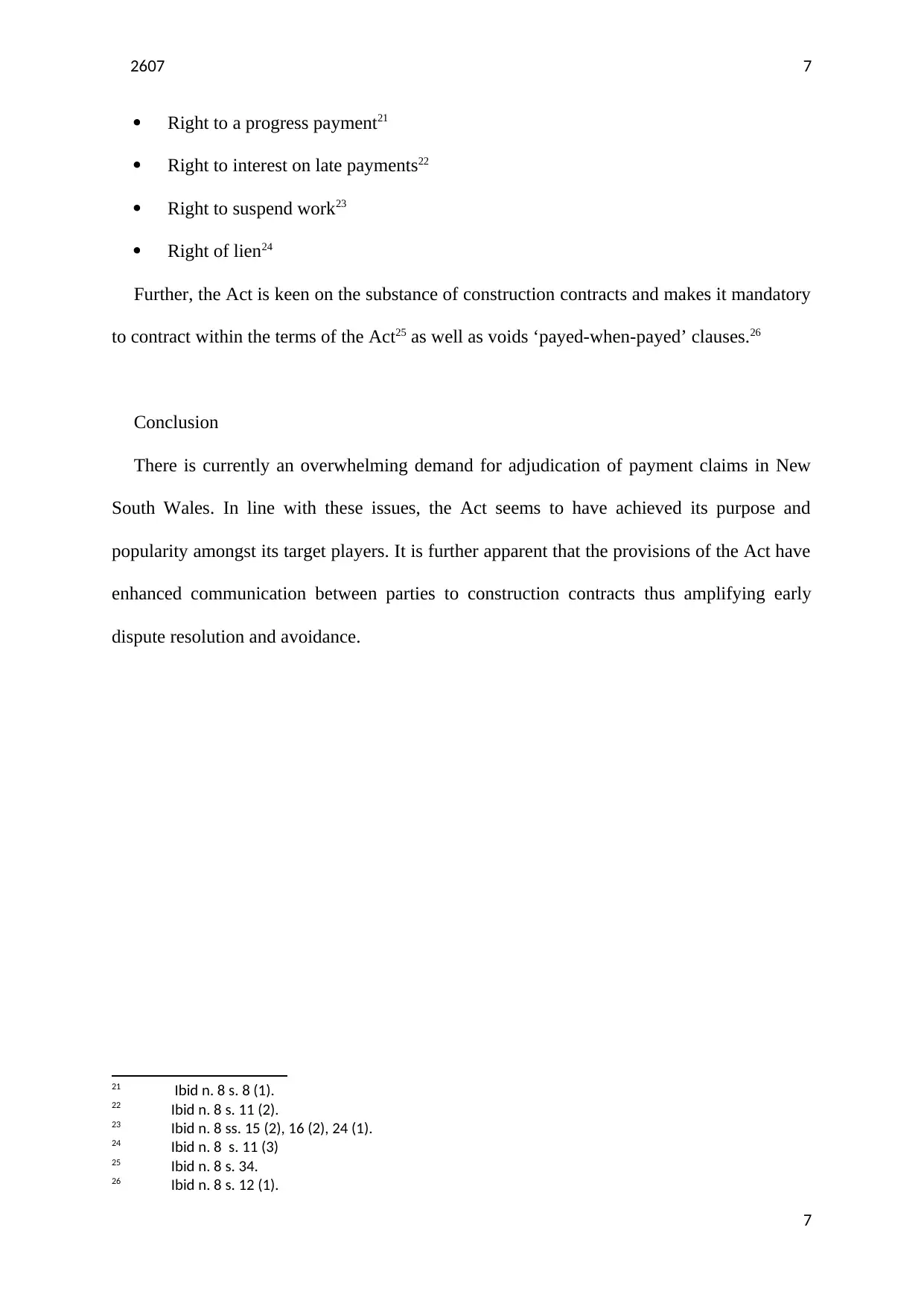
2607 7
Right to a progress payment21
Right to interest on late payments22
Right to suspend work23
Right of lien24
Further, the Act is keen on the substance of construction contracts and makes it mandatory
to contract within the terms of the Act25 as well as voids ‘payed-when-payed’ clauses.26
Conclusion
There is currently an overwhelming demand for adjudication of payment claims in New
South Wales. In line with these issues, the Act seems to have achieved its purpose and
popularity amongst its target players. It is further apparent that the provisions of the Act have
enhanced communication between parties to construction contracts thus amplifying early
dispute resolution and avoidance.
21 Ibid n. 8 s. 8 (1).
22 Ibid n. 8 s. 11 (2).
23 Ibid n. 8 ss. 15 (2), 16 (2), 24 (1).
24 Ibid n. 8 s. 11 (3)
25 Ibid n. 8 s. 34.
26 Ibid n. 8 s. 12 (1).
7
Right to a progress payment21
Right to interest on late payments22
Right to suspend work23
Right of lien24
Further, the Act is keen on the substance of construction contracts and makes it mandatory
to contract within the terms of the Act25 as well as voids ‘payed-when-payed’ clauses.26
Conclusion
There is currently an overwhelming demand for adjudication of payment claims in New
South Wales. In line with these issues, the Act seems to have achieved its purpose and
popularity amongst its target players. It is further apparent that the provisions of the Act have
enhanced communication between parties to construction contracts thus amplifying early
dispute resolution and avoidance.
21 Ibid n. 8 s. 8 (1).
22 Ibid n. 8 s. 11 (2).
23 Ibid n. 8 ss. 15 (2), 16 (2), 24 (1).
24 Ibid n. 8 s. 11 (3)
25 Ibid n. 8 s. 34.
26 Ibid n. 8 s. 12 (1).
7
1 out of 7
Related Documents
Your All-in-One AI-Powered Toolkit for Academic Success.
+13062052269
info@desklib.com
Available 24*7 on WhatsApp / Email
![[object Object]](/_next/static/media/star-bottom.7253800d.svg)
Unlock your academic potential
Copyright © 2020–2025 A2Z Services. All Rights Reserved. Developed and managed by ZUCOL.





